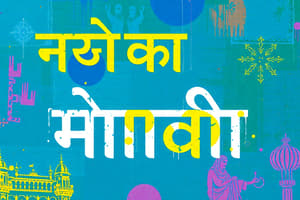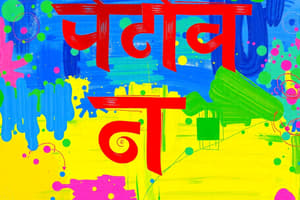Podcast
Questions and Answers
In which country is Hindi chiefly spoken?
In which country is Hindi chiefly spoken?
- Pakistan
- India (correct)
- Bangladesh
- Nepal
How many states recognize Hindi as an official language?
How many states recognize Hindi as an official language?
- Seven
- Five
- Eleven
- Nine (correct)
From which dialect did Modern Standard Hindi evolve?
From which dialect did Modern Standard Hindi evolve?
- Braj Bhasha
- Awadhi
- Bhojpuri
- Khariboli (correct)
Which script is typically used to write Hindi?
Which script is typically used to write Hindi?
What is the term for the combined Hindi-Urdu language?
What is the term for the combined Hindi-Urdu language?
From which language does Hindi primarily draw its vocabulary?
From which language does Hindi primarily draw its vocabulary?
Who is considered one of the earliest known poets of Hindavi?
Who is considered one of the earliest known poets of Hindavi?
What is the status of Hindi according to Article 343(2) of the Indian constitution?
What is the status of Hindi according to Article 343(2) of the Indian constitution?
In which direction is Devanagari script written?
In which direction is Devanagari script written?
Which of the following countries has a significant Hindi-speaking diaspora population?
Which of the following countries has a significant Hindi-speaking diaspora population?
What type of word order does Hindi follow?
What type of word order does Hindi follow?
From which language does a significant portion of Hindi vocabulary originate?
From which language does a significant portion of Hindi vocabulary originate?
Which of the following is another name for the Hindi cinema industry based in Mumbai?
Which of the following is another name for the Hindi cinema industry based in Mumbai?
Hindi nouns are inflected for which of the following?
Hindi nouns are inflected for which of the following?
What is the term for diacritic marks added to consonants in Devanagari to modify vowel sounds?
What is the term for diacritic marks added to consonants in Devanagari to modify vowel sounds?
Besides Hindi, which other language is an official language of the Union government of India?
Besides Hindi, which other language is an official language of the Union government of India?
Which of the following is considered the basis for Modern Standard Hindi?
Which of the following is considered the basis for Modern Standard Hindi?
What is the function of postpositions in Hindi?
What is the function of postpositions in Hindi?
Flashcards
Analytic language
Analytic language
A language structure where word order & particles show grammatical roles.
Noun inflection in Hindi
Noun inflection in Hindi
Gender (masculine/feminine) and number (singular/plural).
Honorifics
Honorifics
Show respect through verbs/pronouns.
Sanskritization
Sanskritization
Signup and view all the flashcards
Devanagari as abugida
Devanagari as abugida
Signup and view all the flashcards
Official languages of India
Official languages of India
Signup and view all the flashcards
Bhakti poetry
Bhakti poetry
Signup and view all the flashcards
Premchand's writing
Premchand's writing
Signup and view all the flashcards
Bollywood
Bollywood
Signup and view all the flashcards
Khariboli
Khariboli
Signup and view all the flashcards
Hindi
Hindi
Signup and view all the flashcards
Article 343(2)
Article 343(2)
Signup and view all the flashcards
Lingua Franca (of Hindi Belt)
Lingua Franca (of Hindi Belt)
Signup and view all the flashcards
Vedic Sanskrit
Vedic Sanskrit
Signup and view all the flashcards
Amir Khusrau
Amir Khusrau
Signup and view all the flashcards
Hindi and Urdu relationship
Hindi and Urdu relationship
Signup and view all the flashcards
Devanagari Script
Devanagari Script
Signup and view all the flashcards
Study Notes
- Hindi is an Indo-Aryan language principally spoken in India.
- Modern Standard Hindi is one of the Indian government's two official languages.
- Nine states and three union territories list Hindi as an official language.
- According to Article 343(2) of the constitution, it is an additional official language of India.
- The Hindi Belt's lingua franca is Hindi.
- Hindi ranks as the world's fourth most widely used language.
Origin and History
- Early forms of Vedic Sanskrit are regarded as the ancestor of Hindi.
- It evolved into Prakrit and then Apabhramsa through various developmental phases.
- The Khariboli dialect of Delhi and the surrounding areas is where Modern Standard Hindi originated.
- In the 18th century, Khariboli rose to prominence, and in the 19th century, it was standardized.
- The standardization was mostly attributable to the work of British administrators and missionaries.
- They intended to create a standardized language that could be used for both administrative and educational purposes.
- During the medieval era, Hindi's literary heritage started to take shape, with works by poets and saints.
- Amir Khusrau is among the earliest known poets to have written in Hindavi, a predecessor of Hindi.
- The Bhakti movement saw an increase in devotional literature written in various Hindi dialects.
- Tulsidas's Ramcharitmanas, written in the Awadhi dialect, is a noteworthy example.
Relationship with Urdu
- The Khariboli dialect is the common ancestor of Hindi and Urdu.
- In its colloquial form, the two languages are mutually intelligible.
- The vocabulary and standardized forms are the primary distinctions.
- Hindi incorporates vocabulary from Sanskrit, whereas Urdu incorporates vocabulary from Persian and Arabic.
- The divergence between Hindi and Urdu was encouraged for political reasons during the British colonial era.
- As a result, distinct literary traditions and scripts were created.
- The Devanagari script is typically used for Hindi, while the Perso-Arabic script is used for Urdu.
- The term "Hindustani" is sometimes used to refer to the combined Hindi-Urdu language.
Geographical Distribution
- Hindi is commonly spoken in northern, central, and western India.
- Uttar Pradesh, Bihar, Jharkhand, Uttarakhand, Madhya Pradesh, Haryana, Himachal Pradesh, Chhattisgarh, and Rajasthan are among the states where Hindi is recognized as an official language.
- It is also an official language in the union territories of Delhi, Jammu and Kashmir, and the Andaman and Nicobar Islands.
- Hindi speakers can be found in other regions of India, particularly in urban centers.
- Hindi is spoken outside of India by diaspora communities in nations including Nepal, Fiji, Mauritius, South Africa, Suriname, Trinidad and Tobago, and the United States.
Structure and Grammar
- Hindi is an analytic language.
- It uses word order and particles to express grammatical relationships.
- The word order in Hindi is subject-object-verb (SOV).
- In Hindi, nouns change depending on gender (masculine and feminine) and number (singular and plural).
- Verbs change depending on tense, aspect, mood, gender, and number.
- Hindi uses a complex system of postpositions, which function similarly to English prepositions.
- Hindi adjectives match the nouns they describe in terms of gender, number, and case.
- The language uses honorifics to show respect.
- Depending on the amount of respect being shown, verb conjugations and pronoun use change.
Vocabulary
- Throughout its history, Hindi has incorporated words from other languages.
- Sanskrit accounts for a sizable portion of its vocabulary.
- It also contains words from Persian, Arabic, English, and other languages.
- The process of Sanskritization entails using Sanskrit terms to purify the language.
- Loanwords from English are prevalent in metropolitan areas and technical domains.
Writing System
- The Devanagari script is used to write Hindi.
- Each consonant in Devanagari, an abugida, has an inherent vowel.
- Matras, which are diacritic symbols added to consonants, can be used to change vowel sounds.
- Devanagari is read from left to right.
- Each word in the script has a horizontal line running across the top.
- Sanskrit, Marathi, and Nepali are among the other languages that employ the script.
Official Status
- Hindi is one of the Indian Union government's two official languages.
- English is the other official language.
- The Indian Constitution initially stipulated that English would no longer be an official language after 1965.
- However, this was changed to allow English to continue to be used alongside Hindi.
- The Official Languages Act of 1963 governs how Hindi and English are used for official purposes.
- There have been discussions and disagreements over the promotion and imposition of Hindi in non-Hindi speaking parts of India.
- The three-language formula encourages students to learn Hindi, English, and a regional language.
Hindi Literature
- Hindi literature has a long and diverse history.
- It includes poetry, prose, drama, and literary criticism.
- The medieval period saw the rise of Bhakti poetry, defined by devotional themes and emotional expression.
- Modern Hindi literature arose in the 19th century with the development of new literary forms and genres.
- Premchand, a novelist and short story writer known for his realistic depictions of rural life; Jaishankar Prasad, a poet, playwright, and novelist known for his romantic and historical works; and Mahadevi Varma, a poet and essayist known for her contributions to Chhayavad, a romantic literary movement, are among the prominent Hindi writers.
- Contemporary Hindi literature continues to evolve, reflecting India's changing social and political landscape.
Hindi Cinema
- Hindi cinema, also known as Bollywood, is a major film industry located in Mumbai.
- Each year, it produces a large number of films, which are popular in India.
- Hindi cinema has a significant impact on Indian culture.
- The songs and dialogues from Hindi films are widely heard and quoted.
- Many Hindi films explore social issues and themes, reflecting the realities and aspirations of Indian society.
- Hindi cinema has gained international recognition.
- It has a large following among the Indian diaspora and in other countries.
Dialects
- There are numerous Hindi dialects, which vary in pronunciation, vocabulary, and grammar.
- Khariboli, Braj Bhasha, Awadhi, Bagheli, Bhojpuri, and Rajasthani are among the major Hindi dialects.
- Modern Standard Hindi is based on Khariboli.
- Braj Bhasha was a prominent literary language during the medieval period.
- Awadhi was the language of Tulsidas's Ramcharitmanas.
- Bhojpuri is spoken in eastern Uttar Pradesh, Bihar, and parts of Nepal.
- The status and recognition of Hindi dialects vary.
- Some are considered distinct languages in their own right.
Learning Hindi
- Hindi is taught as a subject in schools across India.
- Many universities offer Hindi language and literature programs.
- There are various resources available for learning Hindi, including textbooks, online courses, and language learning apps.
- Learning Hindi can be beneficial for those interested in Indian culture, literature, and cinema.
- It can also be useful for those who plan to travel or work in India.
Studying That Suits You
Use AI to generate personalized quizzes and flashcards to suit your learning preferences.
Description
Explore the origins and history of the Hindi language, an Indo-Aryan language and one of India's official languages. From its roots in Vedic Sanskrit to its standardization by British administrators, discover the evolution and significance of Hindi.




